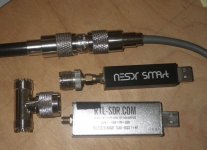Hi all, just wanted to share what I learned trouble shooting my scanner. In a nut shell I stopped receiving one of the UHF ham repeaters on the scanner but it was coming in fine on the UHF transceiver. My first thought was somehow I had made a lockout permanent so I spent some time sorting that out. Next came the antenna and with the UHF rig next to the scanner I thought swapping out the antennas and coax might help sort things out and that's where things went off the rails. Long story short is I now believe the higher gain of the antenna for the UHF rig had enough signal to overcome and mask the real problem. Spent quite a lot of time trying to figure out why both receiver would work on both antennas.
It was not until I removed the Tee next to the rigs that I was able to figure out the true issue. The silver SDR when tested with a DMM showed resistance from the center to the shield when off. The black SDR did not and was fully open when off. I had been swapping them back and fourth trying to sort out an UN-related USB cable issue.
Looking back I now think the silver SDR was causing signal attenuation, enough to completely drop the UHF repeater I was trying to pick up. But it was passing enough signal to let everything else work and make this one of those learning experiences.
Next time - start at the Tee! DOH ;-)
It was not until I removed the Tee next to the rigs that I was able to figure out the true issue. The silver SDR when tested with a DMM showed resistance from the center to the shield when off. The black SDR did not and was fully open when off. I had been swapping them back and fourth trying to sort out an UN-related USB cable issue.
Looking back I now think the silver SDR was causing signal attenuation, enough to completely drop the UHF repeater I was trying to pick up. But it was passing enough signal to let everything else work and make this one of those learning experiences.
Next time - start at the Tee! DOH ;-)


